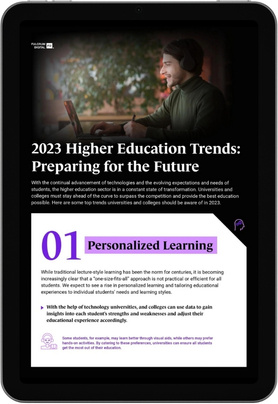Diversity and inclusion are vital in shaping a thriving and equitable learning environment within the higher education industry. Embracing diversity empowers students, faculty, and staff to celebrate differences and fosters an inclusive space. As educational institutions continue prioritizing diversity and inclusion, it is crucial to support these efforts to ensure accountability and progress toward a more conscientious future.
Student Demographics and Representation
Student demographics in higher education provide valuable insights into diversity. Recent data shows a promising increase in student diversity, with underrepresented minority students in the US comprising 46% of all undergraduates in 2021. This progress enriches the academic experience by fostering cross-cultural interactions, and diverse perspectives, and preparing students for the global workforce.
The University of Manchester in the UK is an excellent example with a high proportion of students from historically underrepresented communities as minorities. The university demonstrates its commitment to fostering an inclusive environment. In the 2021/2022 academic year, 41.2% of the university’s UK-domiciled undergraduate students identified as minorities.
Stanford University has prioritized diversity and inclusion, implementing outreach and recruitment programs for underrepresented communities. This effort has resulted in a student body with diverse backgrounds, enhancing understanding and appreciation of different cultures. In 2020, Stanford reported that 22% of its undergraduate students were first-generation college students, with 22% benefiting from their Pell Grant initiative.

Faculty Diversity and Inclusive Practices
Promoting diversity and inclusion encompasses the student body and faculty representation. Encouragingly, there is substantial progress in this area, with increased faculty hiring from diverse backgrounds. There is still work needed, however, to achieve proportional representation across disciplines and seniority levels, especially in UK universities.
According to HESA, as of 2020/2021 only 20.1% of UK university professors identified as female, highlighting the gender imbalance in higher education leadership roles. Faculty diversity is crucial as it drives inclusive teaching practices. This brings varied backgrounds, experiences, teaching methodologies, and mentorship opportunities, enriching the educational experience for students.

2023 HIGHER EDUCATION TRENDS: PREPARING FOR THE FUTURE
Explore the key trends reshaping the higher education industry. Empower your institution with insights to navigate the future effectively!
University College London (UCL) stands out for its initiatives promoting faculty diversity and inclusive practices. In 2020, UCL reported that 34% of its professoriate positions were held by women, showcasing progress toward gender equity.
The University of California, Berkeley, implemented a Faculty Equity Advisor Program to address disparities and biases in faculty hiring, retention, and promotion. UC Berkeley has seen a significant increase in faculty diversity since 2020 with underrepresented minorities rising from 8% to 12%. This increased representation enriches the educational experience by bringing a broader range of perspectives and experiences to the campus.

Strategies for Advancing Diversity and Inclusion
Universities have implemented comprehensive strategies to advance diversity and inclusion on campus. The University of Texas, Austin established the Division of Diversity and Community Engagement to create an inclusive campus environment. This initiative includes targeted recruitment efforts, diversity training for faculty and staff, and implementing inclusive curriculum development.
Institutions that foster diversity and inclusion can employ various strategies to drive positive change. These strategies include:
• Outreach and Recruitment: actively recruiting students from underrepresented backgrounds through targeted outreach programs, community partnerships, and scholarships helps create a more diverse student body.
• Inclusive Policies and Practices: developing policies that promote equal opportunities, providing comprehensive support services, and implementing bias awareness training for faculty and staff contribute to a more inclusive environment.
• Curriculum Transformation: institutions should review and update their curriculum to incorporate diverse perspectives, voices, and contributions. This includes diversifying reading materials, integrating multicultural content, and offering courses on social justice and equity.
• Cultural Competence Training: offering training programs that enhance cultural competence among faculty, staff, and students fosters understanding and appreciation of different cultures, leading to more inclusive interactions.
• Mentorship and Support Programs: establishing mentorship programs, affinity groups, and support networks for underrepresented students and faculty fosters a sense of belonging and provides valuable guidance and support.

Conclusion
Diversity and inclusion are the essential pillars of a progressive and equitable higher education system, offering numerous benefits to students, faculty, and the broader academic community. This cultivates inclusive learning environments for enhancing academic success, critical thinking, and creativity. Institutions have achieved considerable outcomes through intentional efforts to create inclusive learning environments. By embracing diversity and implementing inclusive practices, these institutions have increased access to education and enriched the academic experience, thus inspiring other institutions to prioritize diversity and inclusion for a brighter future for higher education.






